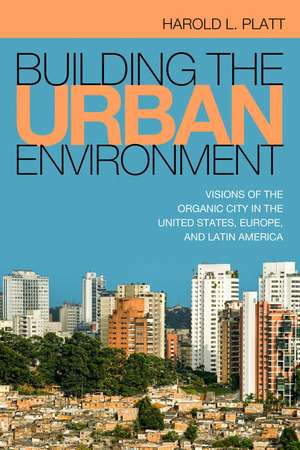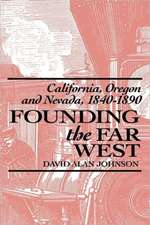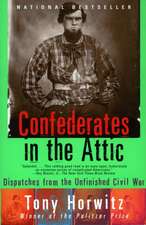Building the Urban Environment: Visions of the Organic City in the United States, Europe, and Latin America: Urban Life, Landscape and Policy
Autor Harold L. Platten Limba Engleză Paperback – 30 sep 2015
Building the Urban Environment is a comparative study of the contestation among planners, policymakers, and the grassroots over the production and meaning of urban space. Award-winning historian Harold Platt presents case studies of seven cities, including Rotterdam, Chicago, and Sao Paulo, to show how, over time, urban life created hybrid spaces that transformed people, culture, and their environments.
As Platt explains, during the post-1945 race to technological modernization, policymakers gave urban planners of the International Style extraordinary influence to build their utopian vision of a self-sustaining “organic city.” However, in the 1960s, they faced a revolt of the grassroots. Building the Urban Environment traces the rise and fall of the Modernist planners during an era of Cold War, urban crisis, unnatural disasters, and global restructuring in the wake of the oil-energy embargo of the ’70s.
Ultimately, Platt provides a way to measure different visions of the postwar city against actual results in terms of the built environment, contrasting how each city created a unique urban space.
As Platt explains, during the post-1945 race to technological modernization, policymakers gave urban planners of the International Style extraordinary influence to build their utopian vision of a self-sustaining “organic city.” However, in the 1960s, they faced a revolt of the grassroots. Building the Urban Environment traces the rise and fall of the Modernist planners during an era of Cold War, urban crisis, unnatural disasters, and global restructuring in the wake of the oil-energy embargo of the ’70s.
Ultimately, Platt provides a way to measure different visions of the postwar city against actual results in terms of the built environment, contrasting how each city created a unique urban space.
Din seria Urban Life, Landscape and Policy
- 19%
 Preț: 526.90 lei
Preț: 526.90 lei -
 Preț: 241.72 lei
Preț: 241.72 lei -
 Preț: 199.08 lei
Preț: 199.08 lei -
 Preț: 188.34 lei
Preț: 188.34 lei -
 Preț: 221.72 lei
Preț: 221.72 lei -
 Preț: 221.89 lei
Preț: 221.89 lei -
 Preț: 196.06 lei
Preț: 196.06 lei -
 Preț: 218.83 lei
Preț: 218.83 lei -
 Preț: 214.70 lei
Preț: 214.70 lei -
 Preț: 247.10 lei
Preț: 247.10 lei -
 Preț: 236.40 lei
Preț: 236.40 lei -
 Preț: 262.38 lei
Preț: 262.38 lei -
 Preț: 206.43 lei
Preț: 206.43 lei -
 Preț: 253.90 lei
Preț: 253.90 lei -
 Preț: 221.50 lei
Preț: 221.50 lei -
 Preț: 223.25 lei
Preț: 223.25 lei -
 Preț: 199.72 lei
Preț: 199.72 lei -
 Preț: 256.89 lei
Preț: 256.89 lei - 23%
 Preț: 510.64 lei
Preț: 510.64 lei - 23%
 Preț: 432.11 lei
Preț: 432.11 lei -
 Preț: 249.45 lei
Preț: 249.45 lei -
 Preț: 260.23 lei
Preț: 260.23 lei - 9%
 Preț: 611.61 lei
Preț: 611.61 lei -
 Preț: 264.85 lei
Preț: 264.85 lei -
 Preț: 252.74 lei
Preț: 252.74 lei - 6%
 Preț: 673.49 lei
Preț: 673.49 lei -
 Preț: 201.35 lei
Preț: 201.35 lei
Preț: 202.90 lei
Nou
Puncte Express: 304
Preț estimativ în valută:
38.83€ • 40.72$ • 32.32£
38.83€ • 40.72$ • 32.32£
Carte tipărită la comandă
Livrare economică 01-15 aprilie
Preluare comenzi: 021 569.72.76
Specificații
ISBN-13: 9781439912379
ISBN-10: 1439912378
Pagini: 302
Dimensiuni: 152 x 229 x 25 mm
Greutate: 0.48 kg
Editura: Temple University Press
Colecția Temple University Press
Seria Urban Life, Landscape and Policy
ISBN-10: 1439912378
Pagini: 302
Dimensiuni: 152 x 229 x 25 mm
Greutate: 0.48 kg
Editura: Temple University Press
Colecția Temple University Press
Seria Urban Life, Landscape and Policy
Recenzii
“Building the Urban Environment is entirely original in its overall conceptualization, synthesis of the literature, and its major arguments. Platt demonstrates how post–WWII planning was conducted within a historical context that valorized specific ideas and visions of the city often at the expense of the people who lived in the city. His analytical framework of the organic city is original and significant. It challenges the reader to reconsider the rationales/rationality of modernism as well as the values upon which so much of the received wisdom of the post–WWII planning of cities was predicated.”—Maureen A. Flanagan, Illinois Institute of Technology
“Building the Urban Environment offers many fresh and powerful insights. Platt makes a convincing case that planners were as much a part of the problem as the solution to many urban ills. His synthesis, within the metaphor of the organic city, is highly effective. It frames the entire discussion in a unique way, and provides a cogent means to incorporate nature into the discussion of the city, and to highlight many of the wrong-headed ideas of modernist urban planning. Building the Urban Environment provides a powerful and penetrating critique that touches not only on environmental issues, but race, labor, housing, and municipal administration at both the local and national levels. Through his effective exploration of multi-continent case studies, Platt enriches the argument for the adoption, the failure, and rejection of the organic city.”—Craig E. Colten, Louisiana State University
Notă biografică
Harold L. Platt is Professor of History Emeritus at Loyola University Chicago. He is the author or editor of several volumes, including Shock Cities: The Environmental Transformation and Reform of Manchester and Chicago, which won the Abel Wolman Award.












